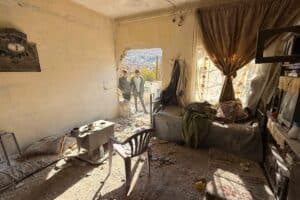Turkish President Recep Tayyip Erdogan on Wednesday firmly ruled out any negotiations with Kurdish militants in Syria.

Russian television on Wednesday showed the first images of Russian and Syrian forces taking up positions in and around the northern city of Manbij following the withdrawal of US troops.
State channel Rossiya-24 showed Russian armoured vehicles patrolling in the city, a day after Moscow announced it had deployed forces in the area.
News channel RT also broadcast footage of US and Syrian convoys crossing paths on the road between Manbij and the city of Kobane on the Syrian-Turkish border.
Russia said Tuesday its military police were patrolling in the area following the withdrawal of forces from a US-led coalition.
Russia said the patrols were taking place after the regime — invited to return by Kurdish forces who lost their US patrons — took control of Manbij.
Syrian forces have moved into several Kurdish-controlled areas as part of a deal to protect the region from an assault by Turkish forces.
Russia’s defence ministry said in a statement on Tuesday that Syrian forces had taken control of more than 1,000 square kilometres (385 square miles) of territory in the Manbij region.
“Syrian authorities and the Russian command have taken all necessary measures to ensure the security of the withdrawing foreign troops,” it said.
Erdogan rules out talks with Kurdish military
Turkish President Recep Tayyip Erdogan on Wednesday firmly ruled out any negotiations with Kurdish militants in Syria, saying their only option was to lay down arms and retreat.
He dismissed calls from foreign powers, including the United States, who have demanded a ceasefire in Turkey’s week-old operation in northern Syria.
“There are some leaders who are trying to mediate… There has never been any such thing in the history of the Turkish republic as the state sitting at the same table with a terror organisation,” Erdogan said in a speech to parliament.
“Our proposal is that right now, tonight, all the terrorists lay down their arms, their equipment and everything, destroy all their traps and get out of the safe zone that we have designated,” he said.
This was “the quickest way of solving the problem in Syria,” he added.
Turkey launched Operation Peace Spring on October 9 with the aim of establishing a “safe zone” across northern Syria, which would push back Kurdish fighters from the Turkish border and allow for the repatriation of Syrian refugees.
Erdogan said that once the safe zone was established, “stretching from Manbij to the Iraqi border”, then the operation would have “ended on its own”.
Syrian Kurds flee for Iraq
Some 500 Syrian Kurds have entered neighbouring Iraqi Kurdistan over the past four days fleeing a Turkish invasion now entering its second week, officials said on Wednesday.
The refugees were taken to camps in Iraq’s autonomous Kurdish region, an official in the border province of Dohuk told AFP.
Iraqi Kurdistan previously hosted more than one million Iraqis who fled fighting with the jihadists of the Islamic State group between 2014 and 2017.
NGOs operating in the region said they had been on alert since Ankara launched its invasion of northern Syria on October 9.
On Saturday evening, 182 Syrian Kurds started crossing the border into Iraqi Kurdistan “to escape bombardments in northeastern Syria”, the International Organization for Migration said.
Dohuk province humanitarian affairs chief Ismail Ahmed said they were “Syrian Kurds already living in Iraqi Kurdistan, who went to visit relatives in Syria before returning because of the bombardments.”
On Wednesday, fresh fighting was reported in northern Syria pitting Turkey’s Syrian proxies against Kurdish forces backed by the Syrian army.
Damascus deployed troops to Kurdish-held areas that had been outside its control since 2012 under an accord with Kurdish authorities announced on Sunday.
Syria and Kurdish fighters keep co-operating a week into Turkish invasion
The Syrian army was deployed alongside Kurdish forces on the front line in northern Syria on Wednesday, with their newfound cooperation showing no signs of letting-up in the week-old Turkish invasion, a monitor said.
In a rare scene in Syria’s eight-year-old civil war, government troops and Kurdish fighters were “fighting together” against Turkey’s Syrian proxies northeast of the town of Ain Issa, the Syrian Observatory for Human Rights said.
The Britain-based monitor reported “violent clashes” near the M4 highway — a key east-west artery that links the Kurdish heartland in the northeast with Syria’s second city Aleppo and the Mediterranean coast beyond.
Under the deal announced on Sunday after President Donald Trump ordered the withdrawal of US troops, government troops have returned to key Kurdish-held areas for the first time in years.
Syrian soldiers have been sent to Manbij, Tal Tamr, Ain Issa and Tabqa in their most significant deployment since the army started withdrawing from Kurdish-majority areas in 2012.
Russia’s special envoy on Syria, Alexander Lavrentyev, said Turkish and Syrian officials were in contact to avoid clashes which “would simply be unacceptable”.
But two Syrian soldiers were killed near Ain Issa on Tuesday in shelling by Turkey’s Syrian proxies — mostly former rebels paid and equipped by Ankara, the Observatory said.
On Monday, artillery fire by the Syrian former rebels killed another soldier in the flashpoint city of Manbij, it added.
In the border town of Ras al-Ain, where Kurdish fighters have put up stiff resistance against Ankara’s incursion, battles raged on Wednesday following a night of heavy Turkish air strikes and artillery fire, the monitor said.
Since its launch on October 9, the Turkish offensive has killed dozens of civilians, mostly on the Kurdish side, and prompted at least 160,000 to flee their homes.
For more news your way, download The Citizen’s app for iOS and Android.






